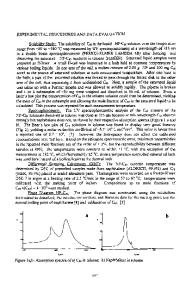Considerations on the Kaufman approach to binary phase diagram calculation
- PDF / 626,725 Bytes
- 6 Pages / 612 x 792 pts (letter) Page_size
- 70 Downloads / 463 Views
FoR
many years Kaufman has been developing and utilizing a particularly simple and attractive approach to calculating binary phase diagrams. Much of this work is summarized in a recent monograph. ~ Focussing attention on that part of the system which deals with equilibria among fcc, bcc and hcp phases, only two components a r e involved: the enthalpy (AH) and entropy (AS) differences between pairs of these phases in pure metals (termed "stability p a r a m e t e r s or SPs), and the regular solution approximation for the free energy of mixing.* Systematic methods for evaluating the *When more data are available, Kaufman and coworkers 1"3 apply higher order analyses to phase diagram calculations.
S i s and the regular solution constants have been developed, essentially without a r b i t r a r y assumptions. Most of the binary systems to which Kaufman has applied this approach involve elements in the Group No. range 4 to 10, with special emphasis having been placed upon r e f r a c t o r y transition metal systems. In the present study, explorations were made of the extent to which this convenient approach can be applied to the Group Nos. 1 to 3 region, which has received considerably less coverage in Kaufman's r e s e a r c h e s . STABILITY P A R A M E T E R S An essential feature of the Kaufman approach is that all M-/and AS values for a particular polymorphic transformation in the elements of a given Group in the Periodic Table should be essentially the s a m e ; a v e r aged AH and ~S data are expected to v a r y s y s t e m a t i c ally with Group No. Plots of such data were developed by Kaufman for Group Nos. 4 to 10, with some data from Group Nos. t and 2 being added onto that of No. 10. In this study, all available data for the SPs of Group Nos. 1 to 3 were obtained and are incorporated K. F. MICHAELS, W. F. LANGE III, and J. R. BRADLEY are
Graduate Students and H. I. AARONSONis Professor, Department of Metallurgical Engineering, MichiganTechnologicalUniversity, Houghton, MI 49931. Manuscript submitted May 16, 1974. METALLURGICAL TRANSACTIONS A
in Fig. l(a) to l(c).* The fit of these data to the c o r *Only the data on Group Nos. 1 to 5 are plotted in Fig. 1, since no additional SP information was obtained for the other half of the Periodic Table.
relation curves, using Kaufman's curves insofar as possible, was then examined. In Group t, the data for Na and Li do not fit well to the curves for the bcc ~ hcp transformation in Fig. l(a). However, the transformation t e m p e r a t u r e s of these elements are somewhat below their respective Debye temperatures. 8 Since this violates a basic a s sumption of the Kaufman approach, these discrepancies can be safely disregarded. For Group 2, only data on Cd and Zn appear to have been used by Kaufman. Data on the S i s for the bcc hcp transformation in Ba, Be and Mg have also been included in Fig. l(a); all of the values for each SP are seen to lie reasonably close to one another. In Fig. l(b), SP values for Ca, St, and Be and Mg have been added. Good agreement
Data Loading...











